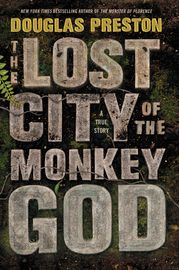Lost City Found

People are forever looking for “lost cities,” if not “the” lost city of some ancient civilization or other. Machu Picchu was billed as “The Lost City of the Incas,” but it turned out to be a summer retreat for Incan one percenters.
Adventurers, archaeologists and writers periodically launch such grandiose scavenger hunts, generally deep in some forbidding jungle. Douglas Preston, author of best-selling thrillers as well as non-fiction books and magazine articles, accompanied a recent quest to find a mysterious metropolis long hidden in the Honduran hinterlands, where poisonous snakes, infectious insects and jaguars lurk.
Spanish conquistador Hernán Cortés started the rumor mill grinding in 1526 when he wrote to Emperor Charles V about a fabulously wealthy people, purported to be ensconced deep in the Central American wilds, whose wherewithal “will exceed Mexico in riches.”
As lost city reportage goes — and despite occasional hyperbole and the obligatory over-the-top title — "The Lost City of the Monkey God: A True Story" (Grand Central, 302 pp., three out of four stars) — is a well-documented and engaging read. Preston and fellow travelers do investigate the ruins of an ancient “city” (for want of a better word: it was merely half again as large as Central Park).
This off-the-grid burg is so hidden in the Mosquitia rain forest that Preston terms it “scientifically untouched,” littered with valuable artifacts lying right where their creators left them some 500 years ago — when this unknown, non-Mayan people suddenly abandoned the site.
The author’s narrative is rife with jungle derring-do and the myriad dangers of the chase, highlighted by the deadly fer-de-lance, a snake so scary it would give Indiana Jones pause. Preston also ably delineates other important aspects of the expedition: for example, how advances in technology have transformed modern archaeology.
This eminently remote place was not only found, but its dimensions and various public spaces were demarcated — thanks to LIDAR, a laser-mapping, jungle-penetrating device that previously plotted the surface of Mars for NASA. Otherwise, it would have taken archaeologists decades of scraping in the dirt to uncover the extent of this missing municipality, assuming they could find it.
Preston places the expedition in the context of past efforts to locate the various haunts of a historically elusive people who established and then abandoned a thriving culture. He speculates on the likely cause for that and explains why such relic-rich sites often acquire the reputation of being “cursed.”
It is not an unreasonable supposition: many members of the expedition, including the author, were afflicted with worrisome, and in some cases grievous, health issues stemming from their time at the site. Sand flies, it turns out, are scarier than snakes and jaguars.
The author dutifully devotes space as well to the controversy in academic circles about this well-hyped archaeological sortie. One complaint is the splashy language used to describe its findings — with the book’s title being exhibit A. One “highly respected authority on Honduran prehistory” characterized the exploration crew this way: “(T)hey are adventurers and not archaeologists. They’re after spectacle.”
Spectacle aside, this book depicts an ambitious expedition that clearly has advanced understanding of an ancient and little-known culture.